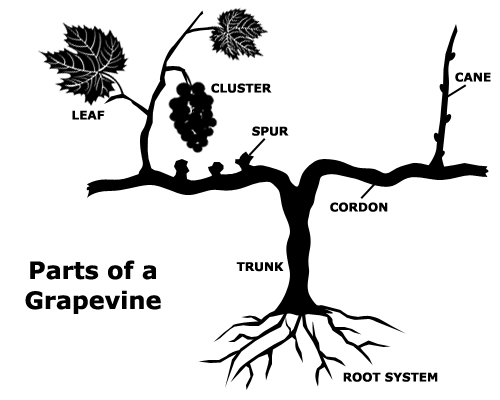Garden Tasks, How-Tos, and Guides:
LitterPicking | RatHarassment | SprayingMicrobes | Composting | PruningTreesandShrubs | Companion Plants for Street Tree Pits | Tree Pit Gardening | HandMulching | GroundCoverManagement | WeedingGuide
Litter picking & disposing of trash
- Use the litter picker (aka garbage grabber) tool.
- If there are no plastic bags, collect trash in a bucket, and empty into the corner trash bin (if the nearby corner trash bin is full, try any of the other corner trash bins).
- Do not throw away organic matter (leaves, branches, dead plants, etc.)
- Only pick plastics (candy wrappers, cups, lids, straws, etc.), metals (bottle caps, cans, old nails, etc.), glass, and mixed materials (glass + wood + plastic + metal).
Rat harassment
- Destroy rat burrows/rat holes. If Stalite gravel (available via GreenThumb and DSNY–talk to garden board to order) is available, fill the holes with the gravel (rats do not like digging in gravel).
- Keep areas clear and clean where rats can hide behind.
- Keep bins and containers away from the walls, at least 2 feet away, so rats don’t have easy cover to hide and dig holes.
- Spray microbes in areas most frequented, against rat residue/odor, which rats use to retrace their steps to their burrow and food and water sources. See below.
Spraying microbes
- EM-5 Brief, Explanations, Recipe, and Instructions
- Hose-end sprayer (instructions)
- Hand-pump Sprayers (instructions)
- Pump Spraying Activated EM
- Mist Spraying EM-5 and Activated EM (foliar and soil applications against pest issues)
EM-5 Brief, Explanations, Recipe, and Instructions
EM-5 is originally a foliar spray (to plants and tree leaves), as well as, a soil inoculant. The recipe to making EM-5 includes food-grade ingredients (blackstrap molasses, apple cider vinegar, 40% alcohol [e.g., vodka, tequila, etc.], garlic cloves, and hot peppers [see list below]) and EM-1, a microbial inoculant used in farming, gardening, composting, and environmental applications. EM-1 is OMRI Listed (Organic Materials Review Institute, omri.org – OMRI Listed products can be used by certified organic operations); Registered with CDFA’s (California Department of Food and Agriculture) Organic Input Material Program, which registers materials to be used in organic crop and food production; Certified Organic by CCOF (California Certified Organic Farmers, ccof.org); is USDA Organic; and is a USDA Certified Biobased Product [Product 99%] which identifies “products made from renewable resources composed wholly or significantly of biological ingredients – renewable plant, animal, marine or forestry materials.”
Video tutorial with background on EM-5 spray. Against rat residue/odor, which rats can track back to their burrow and food/water sources. The recipe and other information are available at the Recycle Food Waste page. For the container we are using as of 2021, the recipe involves the following: 1 cup each of: EM-1 Microbial Inoculant, blackstrap molasses, vodka, and vinegar. Fill the rest of the container with water. Add 2-3 crushed cloves of fresh garlic and a few tablespoons of hot pepper flakes. All should be available in the greenhouse. Label the container with the date that you mixed the solution. The solution is ready to use two weeks after it is mixed.
While the main purposes of the following liquids (EM-5 and Activated EM recipes) are used to improve soil microbial health and plant health (i.e., keep pests at bay), they can also be used to manage odors and trace residues, such as, from rats.
Spraying or watering with EM-5 which is a microbial inoculant made with EM-1 (a combination of beneficial microorganisms), blackstrap molasses, apple cider vinegar (white vinegar is also okay if mainly used against rat residues/odor), vodka (or any cheap 40% alcohol, such as, Tequila and whiskey), and optionally garlic cloves and the hottest spicy peppers that’s available (Scoville rating/pungency(heat/spiciness) above 25K—25,000 SHU. Can be same or mix of peppers, examples:
cayenne [30K-50K],
Satan’s Kiss peppers [40K-50K],
Thai orange peppers [50K-100K],
Bird’s Eye (Thai chili, Piri Piri) [50K-350K],
Scotch bonnet [80K-400K],
habañero [100K-350K],
ghost pepper [850K-1M+], etc.
Generally, EM-5 is used as a foliar spray and to soil to prevent pests and against fungal diseases. The hypothesis is that EM-5 may be breaking down (not just washing away) the pheromones that rats secrete when their furs rub against as they run around—how they know where they’ve been and relocate food and their burrow. Rats have one of the most sensitive senses of smells and can map where things are according to odor. If their pheromones have been disrupted, they tend to stay away from confusion and being cautious.
Spray every two weeks or once a month. Otherwise, whenever they start to reestablish their route again.
Use the hose-end sprayer to spray either the entire garden or sections of the garden.
Use the pump sprayer for localized applications, such as, in your garden bed.
Hose-end sprayer
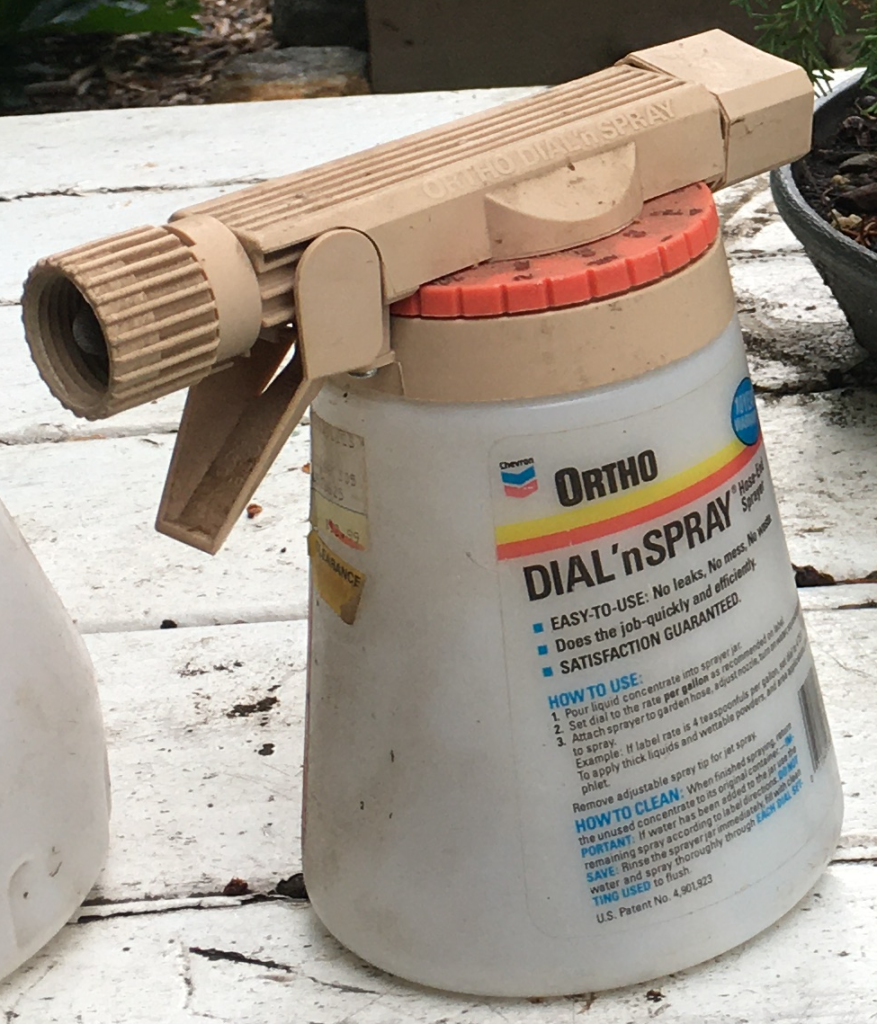
- Fill the hose-end sprayer container with only concentrated EM-5 (max 32 fl oz).
- Set the red dial to 1.5 oz. (for every gallon of water that passes through, 1.5 fl oz of the EM-5 is sucked up into the water stream).
- Attach garden hose.
- Spray affected areas methodically, sweeping side to side while moving over the area.
- Below table shows the percentage per dial setting, and for which application should the dial be set (foliar – spraying to leaves; direct to soil; or for flushing out rat odors).
Example, setting at 1 tsp, means that for every gallon (128 fl oz) of water that goes from hose through the device, 1 teaspoon (or 0.17 fl oz) of whatever liquid is in the container/Ortho device is drawn into the flow and sprayed out mixed with the water. This is pretty much the standard application rate of 1:1000 (0.10% ratio) for spraying EM-5 onto plant [over and under] leaves as a maintenance against pests and foliar feeding (providing nutrients through the leaves).
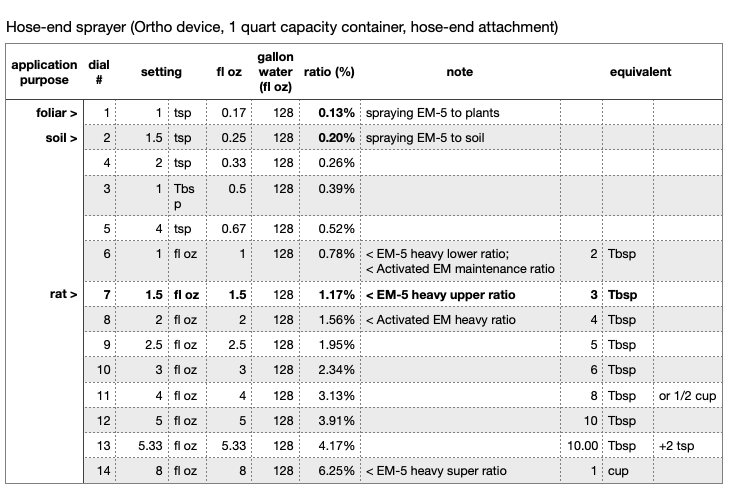
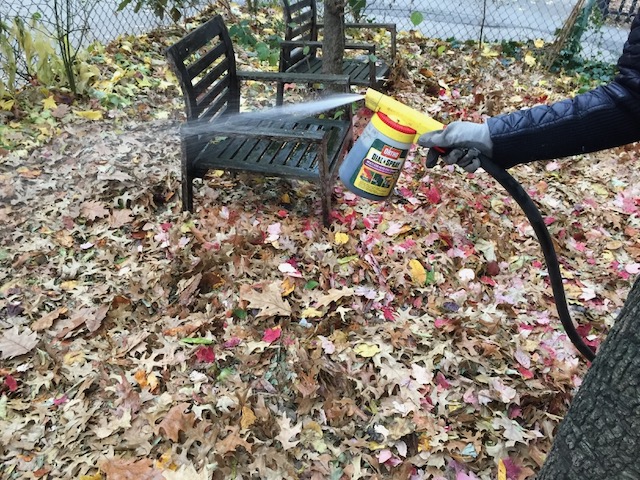
Hand-pump Sprayers

Pump Spraying EM-5
Pre-mix the EM-5 in water in the pump sprayer container.
For rat odors, use 4 teaspoons for 65 fl oz of water,
or less than <1 tablespoon for 40 fl oz of water.
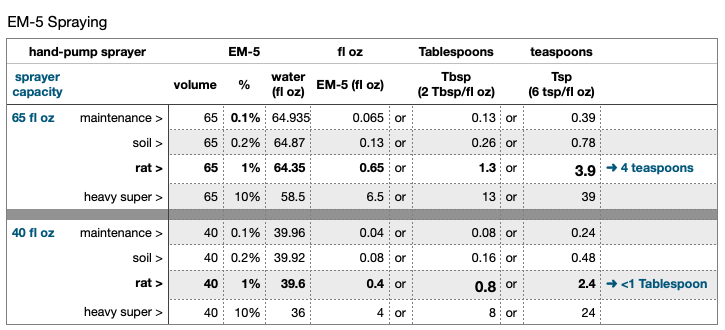
Pump Spraying Activated EM (AEM or just ‘Activated’)
Apply AEM in addition to EM-5. AEM is just EM-1 and blackstrap molasses without the other ingredients. Activated EM is a microbial inoculant for plants, trees, soil, compost, as well as, gray water, black water, and compost toilets. It improves soil microbial health, many other microbes, worms and insects eat these microbes, and it works well for odor management (basically by replacing the bacteria that produces the malodorous molecules/gases, and also by changing the conditions minimizing the ability/functioning of the malodor-causing bacteria).
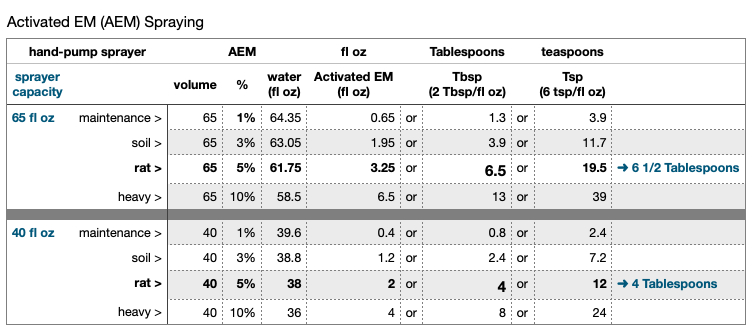
Mist Spraying EM-5 and Activated EM (foliar and soil applications against pest issues)
Plant pest issues include aphids, whiteflies, mites, etc. Apply EM-5 and/or Activated EM as below, and either add neem** as necessary, or add neem as part of the ingredient when making EM-5.
Fungal issues include cedar-apple rust and related rust diseases, powdery mildew, black spot (roses), etc. Make sure to use the EM-5 that was made with garlic cloves, and apply as shown below.
** Neem: “… dried leaves used to prevent insects from eating clothes; dried leaves burnt to keep mosquitos away; a natural alternative to synthetic pesticides. “Neem seeds are ground into a powder that is soaked overnight in water and sprayed onto the crop. To be effective, it is necessary to apply repeatedly, at least every ten days. Neem does not directly kill insects on the crop. It acts as an anti-feedant, repellent, and egg-laying deterrent, protecting the crop from damage. The insects starve and die within a few days. Neem also suppresses the hatching of pest insects from their eggs. Neem cake is often sold as a fertilizer.[11]”
“Neem oil: prevents termite infestation; ecofriendly method.”
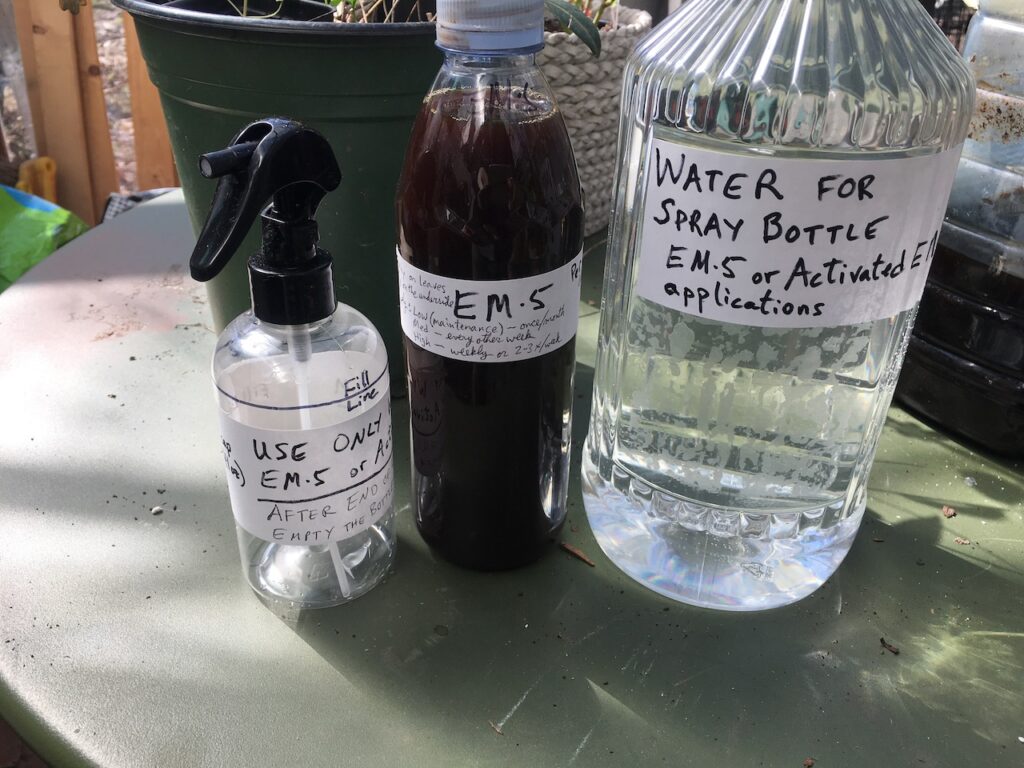

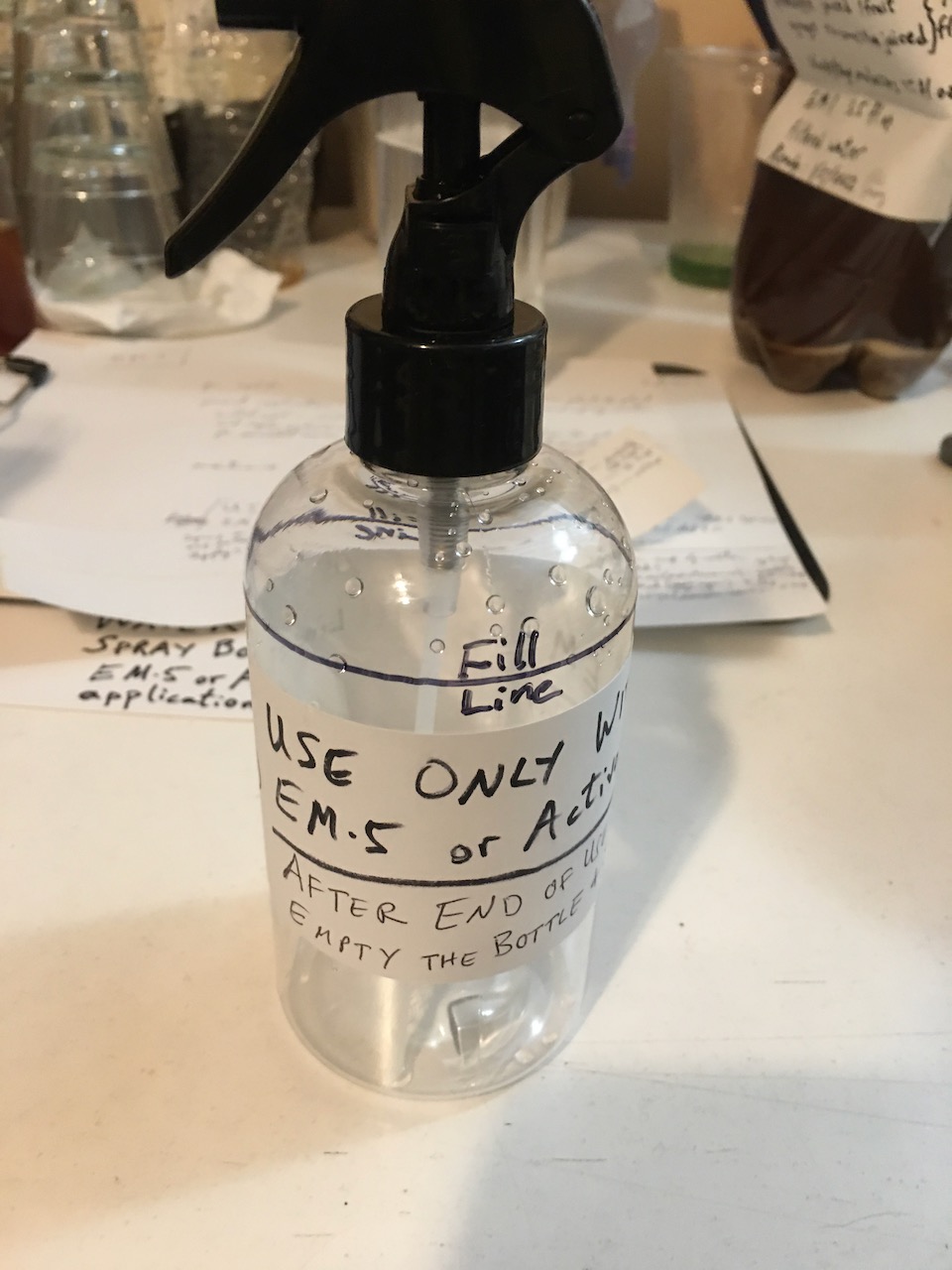
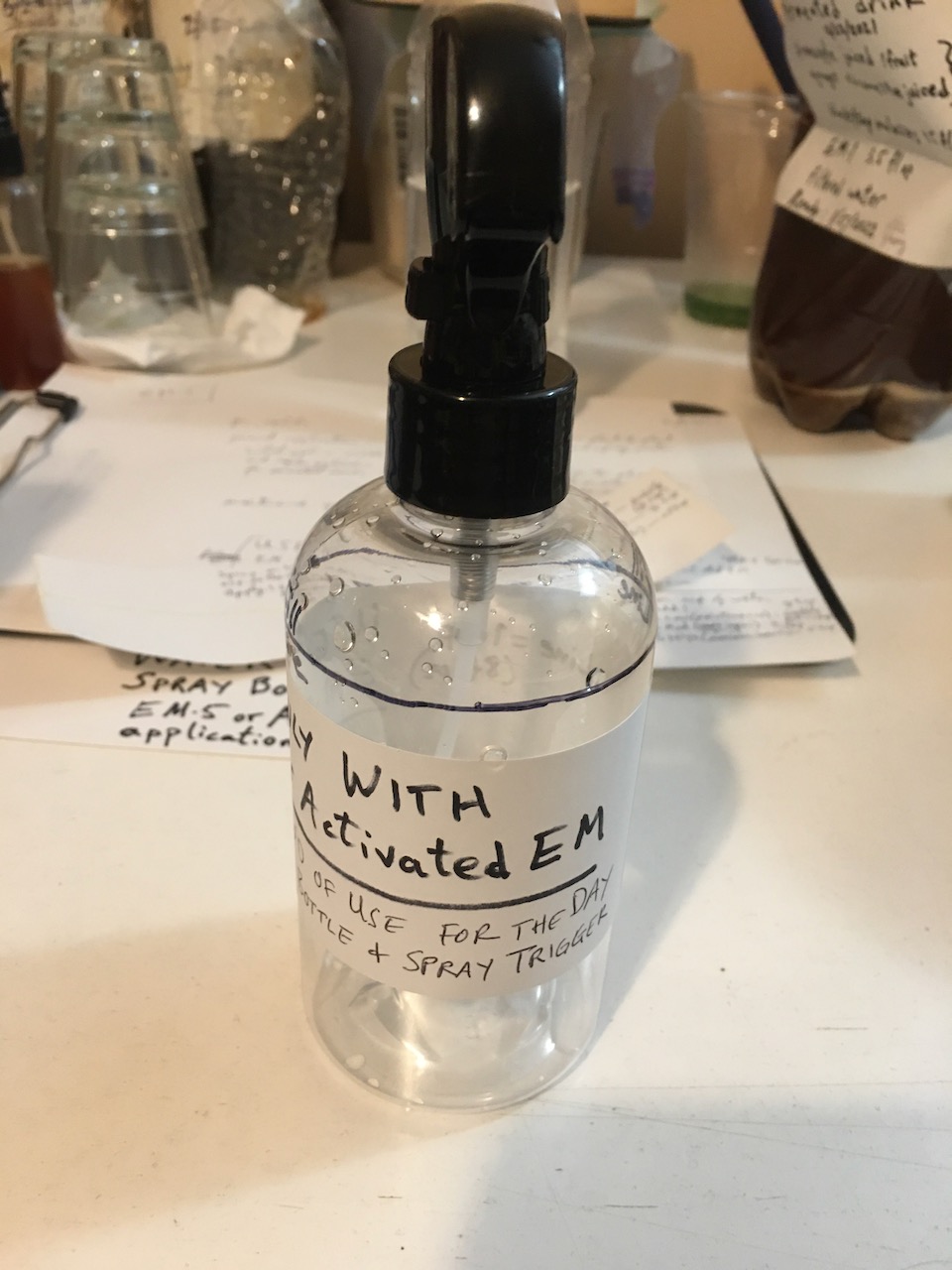
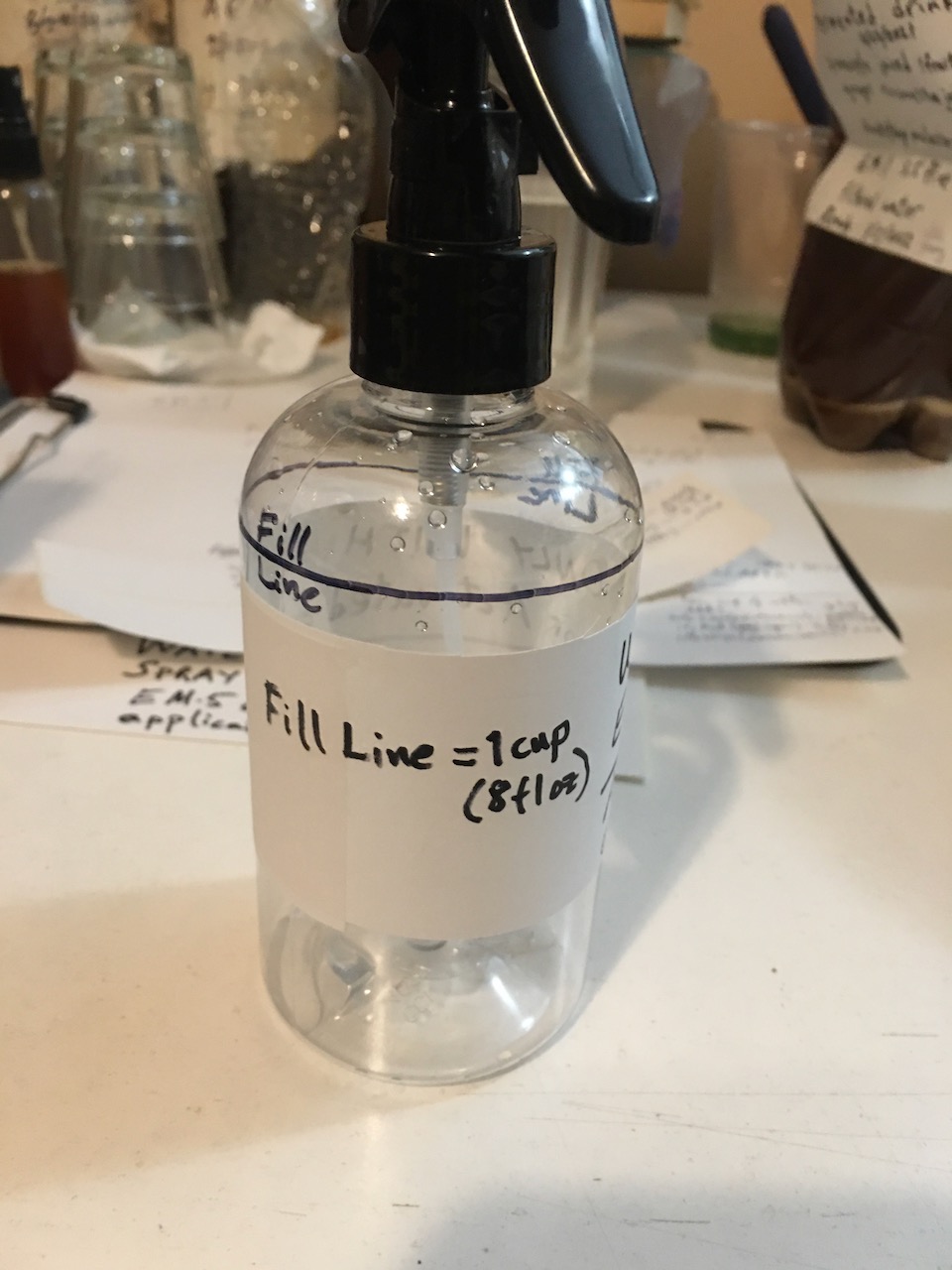
EMPTY THE BOTTLE AND TRIGGER. After end of use for the day, empty the spray/mist bottle and its trigger (after removing the trigger, squeeze the trigger to empty out the liquid). You can pour any remaining liquid content onto the soil which should help it.
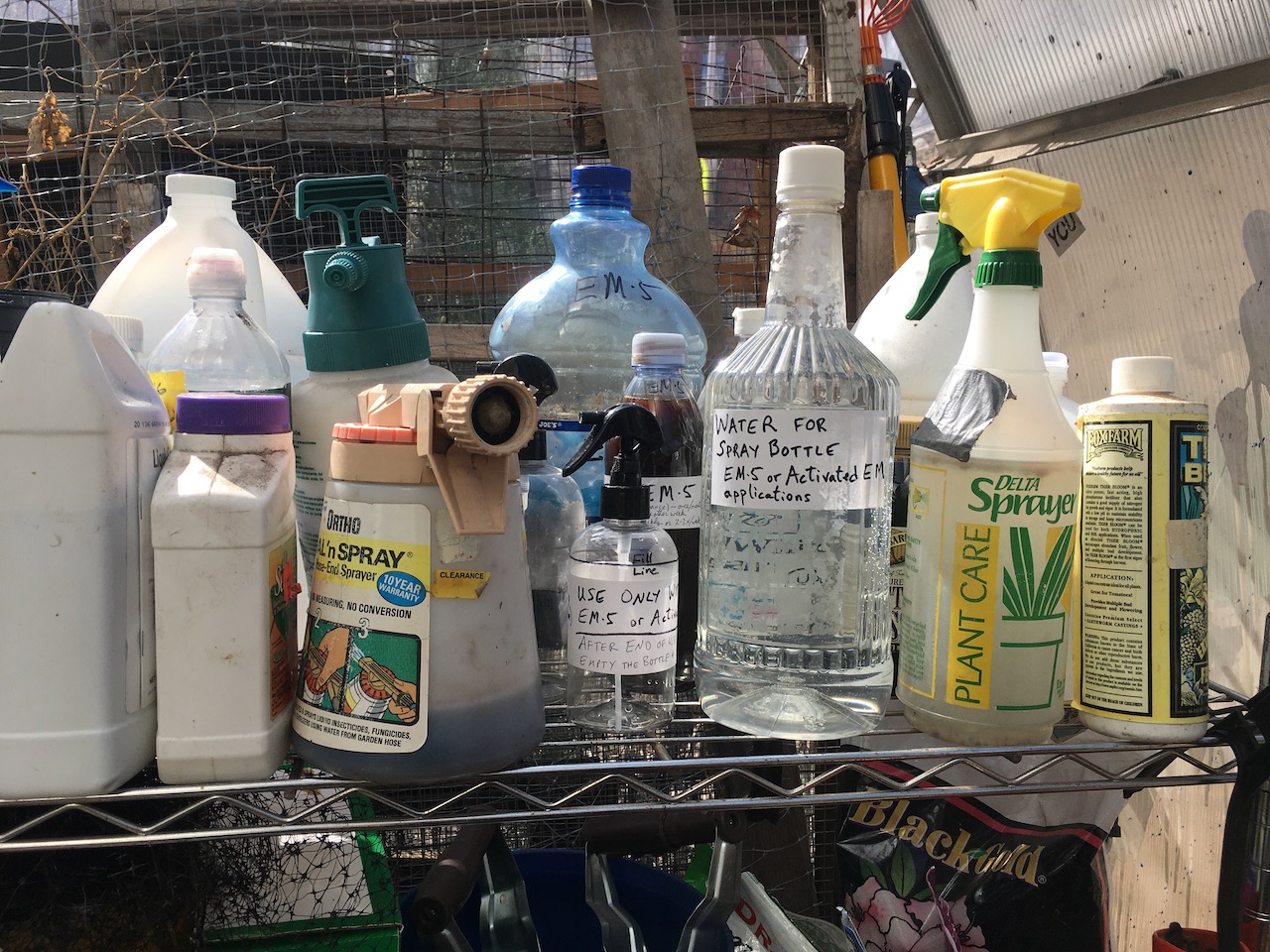
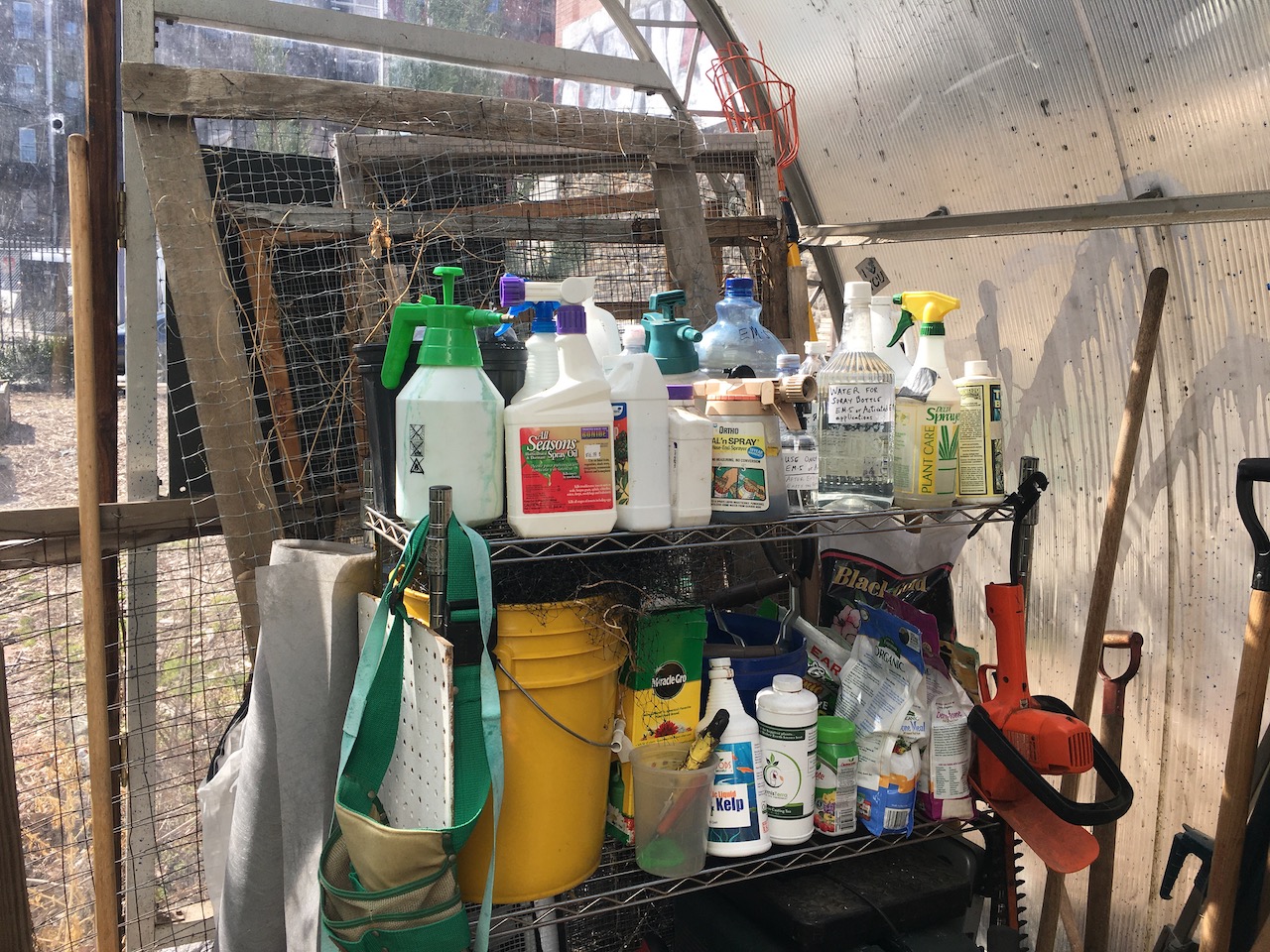
Please notify the garden (via the garden email) whenever we get low on EM-5, Activated EM, neem, or other items (incl. IPM, Integrated Pest Management, items). We will then make more EM-5, Activated EM, or get other items.
Composting Food Waste
For composting in general and an overview, see commongroundcompost.com and view their “How to Compost” and “Learn” menus.
For bokashi composting, see recyclefoodwaste.org.
Pruning Trees and Shrubs – Guide
8/30/2020
Oregon State University Extension Service, Oregon Master Gardener Association, 2-page PDF guide:
https://extension.oregonstate.edu/sites/default/files/documents/12281/pruningtreesshrubs.pdf
03/14/2021
Only gardeners who have been certified as Citizen Pruners are allowed to work on trees and larger shrubs. It is a violation of the GreenThumb license agreement for non-certified gardeners to do any tree pruning. GreenThumb subsidizes free training for gardeners to be certified as Citizen Pruners through TreesNYC. The garden board will send out notifications when spots are available for this training. As of 2021, only Shig and Ryan are certified as Citizen Pruners.
- Tree and shrub care tools: The garden currently owns the following for tree care: 2 telescoping pruning saws, one hand pruning saw, various old saws (these should not be used), 4 loppers, and some snips. We also have liquid copper, neem oil, and all seasons oil for pest management, as well as spray canisters and a hose nozzle for applying these substances
- Aim of pruning: The goal of any pruning is to allow the plant to channel energy into the most productive branches, and to reduce overgrowth and tangle, which diminish airflow and create ideal conditions for diseases and pests.
- General principles: When pruning any woody plant (tree or shrub), first remove dead and diseased branches. Then remove any crossing branches, or any branches with “narrow angles of attachment.” If a tree or shrub has been unpruned for many years, it can take many successive prunings over the course of multiple years to get the tree or shrub back into shape, since it is unadvisable to prune off too much during a single session. Although opinion differs somewhat, in general, any time is a good time to prune. The primary exceptions are fruit trees and shrubs, which may respond better to pruning in late fall, right before the start of dormancy, and late winter, right before the spring awakening.
- Care of specific trees and shrubs
- Grape vine. Notes based on the GreenThumb webinar held in March 2021. Contact Ryan for a link to the recording.
- When to prune: Pruning should be done in late winter, around mid-March. A second small pruning can be done in mid-summer to thin out unproductive growth and channel more energy into fruit production. These notes are chiefly intended to describe the late winter pruning.

- When to prune: Pruning should be done in late winter, around mid-March. A second small pruning can be done in mid-summer to thin out unproductive growth and channel more energy into fruit production. These notes are chiefly intended to describe the late winter pruning.
- Plant structure. For trellis/pergola grown grape vines, there should be single dominant trunk rising straight up through the trellis grate with no suckers, cordons, or branches coming off the lower trunk. A single “cordon” (large branch) should then angle almost 90 degrees across the trellis. Off of this cordon, spurs (mid-size branches) should grow evenly spaced, 6 inches apart. From these spurs, canes (smaller branches) should be allowed to grow. Canes bear leaves and fruits. Leave tendrils in place, as these allow the vine to attach to the trellis. If needed, use arbor tape to secure the trunk, cordon, and spurs in place.
- What to prune: Old growth (three years and older) is unproductive, disease-prone, and should be cut off. Second year growth is the most productive for foliage and fruit and should be retained. Some new growth (one year old) can also be retained for future seasons, but remove excess new growth. Old growth is darker in color, will have exfoliation on the bark; new growth is lighter and has smoother bark with a shinier surface. Remove all cordons, spurs, and canes from the trunk, except for the primary cordon growing over the trellis. Removed spurs and canes have potential to be grafted onto new rootstock.
- How much to prune: A maximum 30% of growth should be removed during the late-winter pruning. If the vine has gone unpruned for many seasons, you may need to do successive hard prunings over the course of several seasons to get the vine back into ideal shape
- Each spur you are retaining should be pruned back to the third node from its base. Make a 45-degree cut just above the node.
- Arbor tape can be used to help affix the trunk and cordons to the climbing structure during and after pruning if needed. Masking tape or cloth tatters can also be helpful during pruning to help mark the cordon(s) and spurs you are planning to retain, to prevent unintentional cuts.
- Feeding: Grape vines prefer well-aerated, poor quality soil. Nonetheless, late winter is the perfect time to boost the vine’s nutrients by adding some compost to the soil around the vine. Dig a trench, 3-4 inches deep, in a donut shape around the trunk at a distance of 12 inches from the trunk. Add mulch to the trench, cover with soil. Mulch around the trunk with untreated cedar mulch, but leave a little space around the trunk base
- Watering: grape vines abhor permanently soggy conditions–water deeply but allow the soil to dry between waterings. If this is not possible, amend the soil with sand, perlite, or another inorganic aggregate to promote better drainage and aeration.
- Grape vine. Notes based on the GreenThumb webinar held in March 2021. Contact Ryan for a link to the recording.
- Fruit trees: The garden has several fruit trees, including a plum tree, two apple trees, a peach tree, a mulberry tree, a crabapple tree, and some ornamental cherries, as well as two fig shrubs. Grape vines are discussed in a separate section. Notes are compiled by Ryan, based on the Open Orchard School series offered by GreenThumb in 2020. Contact Ryan if you would like a link to the recordings.
- When to prune:
- What to prune:
- How much to prune:
- Pest management:
- Feeding:
- Watering:
- Grafting and propagation:
- Transplanting:
Companion Plants for Street Tree Pits
Main source: TreesNY
Shade-Loving Annuals
Impatiens spp. (genus, has 1000+ species)
Species: Impatiens walleriana (aka Busy Lizzy, Patient Lucy, Sultanas), succulent perennial herbs, annual bedding plant, blooms all summer, full shade plant, wide variety of colors, 6 inches to 2 feet tall, wilts when dry (helps to indicate when tree also needs watering).
Soil need: moist, well-drained, supplemented with organic material (compost, mulch, leaves).
Note: over-watering can cause rot.
Begonia spp. (genus, about 1300 species of annuals and perennials; shrubs and climbers)
Species: Begonia x tuberhydrida [previously known as Begonia x semperflorens-cultorum] (aka Wax Begonia, Wax Leaf Begonia, bedding begonia, annual begonia) 6 inches to 8 inches tall (other species up to 2 feet tall), green or brown foliage (depending on cultivar), attractive flowers (red, pink, or white), continually flowers throughout summer, drought tolerant.
Partial shade or filtered sunlight; burnt flowers and leaves if excessive sun exposure; if too much shade, more foliage, less flowers.
Plant 6 to 8 inches apart after last frost.
Lobularia maritima (Sweet Alyssum)
Coleus scutellarioides (Coleus genus, annual or perennial herbs or shrubs)
Lobelia erinus (Dwarf Lobelia)
Sun-Loving Annuals
Pelargonium x hortorum (Geranium)
Salvia splendens (Scarlet Salvia)
Tagetes spp. (genus, 56 species) Marigold.
Perennial Groundcovers
Hedera helix (English Ivy)
Vinca minor (Periwinkle, Myrtle)
Lamium maculatum (Dead Nettle)
Shade-Loving Perennials
Alchemilla mollis (Lady’s-Mantle)
Brunnera macrophylla (Siberian Bugloss)
Hosta spp. (genus, 70+ species), aka Plantain Lily, Hosta
Phalaris arundinacea ‘Picta’ (Variegated Ribbon Grass)
Spring-Flowering Bulbs
Muscari spp. (genus, about 30 species; perennial bulbous plants)
Crocus spp. (genus, 90 species; Crocus)
Chionodoxa luciliae (Glory-of-the-Snow)
Mertensia virginica (rhizome, aka Virginia Bluebells)
Narcissus spp. (genus, 50 species; Daffodil, Narcissus)
Scilla siberica (Siberian Squill)
Tulipa spp. (genus, 100 species of perennial bulbs) Tulips
Tree Pit Gardening
Tree Pit Care / Tree Bed Gardening
Watering: thorough and deep watering during spring and summer.
NYC street trees live in permanent drought conditions.
- if with garden hose, low flow setting (use either shut-off valve at mid-setting or hose trigger head on low setting) for slow and deep watering for 15-20 minutes.
- or use a large container (e.g., 20-gallon container) with holes on/near the bottom (or use 1/8-inch nail or drill to make 2 holes near the bottom of the container 1 inch apart); place the container at the edge of the tree pit with holes going into the tree pit; fill with 10-15 gallons of water (use a 5-gallon container, 1/2 filled [any more, too heavy to carry], 4 to 6 times).
Mulching:
- Mulch cover layer should be 2-3 inches thick, but not more (any more can prevent water, especially rain water, from reaching into the soil).
- Keep the area around the base of the tree clear of mulch, about 6 inches away from the trunk (mulch should never touch the trunk).
- The trunk flare should be visible.
Benefits:
- conserves water
- moderates soil temperatures
- improves soil structure
- mitigates damage from …
- dogs
- people
- de-icing salts
- cleaning agents
Mulch materials include
- wood chips
- pine needles (e.g., mulched Christmas trees)
- leaves
- hand-mulched plant clippings and small branches.
Tree bed gardening:
- Beautifies with
- flower, foliage, groundcover plants (see Companion Plants for Street Tree Pits)
- mulch cover
- Deters walking in the beds
- an actively maintained tree pit
- lush with flowers, foliage, and groundcover plants
- trash removed regularly
- Soil care:
- add enriching organic matter (compost, mulch, hand-mulched plant matter)
- use hand cultivator to loosen the soil (improves aeration and drainage)
- plantings:
- Spring plantings: annuals (e.g., impatiens, coleus, begonias).
- Fall plantings: bulbs (e.g., muscari, crocus, daffodil).
(see Companion Plants for Street Tree Pits)
Hand Mulching Guide for Garden Members & Volunteers
- Mulch (cut into small pieces) pruned plants, plant clippings, dead plants, and small branches. Large branches can be trimmed and used for other purposes, including bed border buffers, for growing mushrooms, or for soil prep uses.
- Depending on plant-matter size (plants, thick plants, branches), use a hand pruner, loper, or hand saw (if available).
- Put/drop the small pieces onto paths between raised beds and over dirt paths (not over grassy areas); larger pieces that may be harder to walk on (such as thick pieces of branches even if they’re only an inch long) put them in non-walking common areas, such as around trees.
Ground Cover Management Guide
- Raking and spreading fall leaves, as well as, hand mulched plant clippings:
- over dirt paths, this prevents muddy paths after rain, and prevents dusty conditions if no rain for awhile.
- over dirt around and between plants, keeps moisture in the soil, which keeps beneficial organisms working in the soil to feed the plants (microorganisms, worms, soil insects), and minimizes the need to constantly water or prevent plants from dying too quickly from a fast-drying soil.
- Ground cover keeps moisture in the soil which is necessary for all kinds of small organisms to flourish (microorganisms) which feed larger organisms (worms, soil insects), and they feed the birds.
- Allow certain beneficial ground cover plants to grow, as appropriate, including ground ivy (Glechoma hederacea), Wild Ginger (Asarum canadense), Bearberry (Arctostaphylos uva-ursi), Appalachian Barren Strawberry (Waldsteinia fragarioides), Pennsylvania Sedge (Carex pensylvanica), etc.
Weeding Guide
- Only paths, mulch-covered, dirt, and brick/paved paths, should be kept clear of weeds. Other areas, including common areas should be weeded, removed or just cut/pruned, on a case-by-case basis (consult with other garden members).
- These cut weeds should be hand-mulched and left on the path as ground cover (raised beds area and common areas).
- Weeds in other areas: if in garden plots, it is the responsibility of the member assigned that plot; if in common areas, consult with other garden members since certain plants which may be considered as weeds are actually beneficial, for example, as ground cover (see Ground Cover Management Guide, above), as nutrient source and balance for other plants that we do want, and for other properties (some weeds are edible and/or attracts beneficial insects, etc.)
- Common weeds in garden that can be pulled out (many are edible or medicinal, feel free to take them home!):
- Mugwort (Artemisia vulgaris and other members of the Artemisia genus): herbal, pleasant aroma, edible (cooked, fried, soup, etc.); various benefits (anecdotal), but insufficient evidence/studies—caution for certain individuals, pregnant women should avoid or simply not eat this; invasive—can take over an area and difficult to remove if not properly contained; can repel insects; may not be compatible with some plants grown closely (see other plants’ specific companion and incompatible plants).
- Pineapple weed (Matricaria matricariodies, Matricaria discoidea): fern-like winter or summer annual; crushed flowers smell like chamomile/pineapple; edible in salads, herbal tea.
- Wild carrot / Queen Anne’s lace (daucus carota): fernlike biennial (blooms in second year), hairy stem; considered invasive weed; carrot-like taproot edible when young; for overly sensitive individuals, use garden gloves when handling wild carrot plants if it causes skin irritation; WARNING: if it does not smell like a carrot, then it may be either poison hemlock (Conium maculatum) with smooth stem, or fool’s parsley (Aethusa cynapium)—both smell bad.
https://www.gardeningknowhow.com/ornamental/flowers/queen-annes-lace/queen-annes-lace-plant.htm - Virginia creeper (Parthenocissus quinquefolia): can be used as climbing vine or ground cover; leaves with typically 5 leaflets turns brilliant colors (mauve, red, purple) in the fall; non-destructive to walls/structures—the ends of tendrils are disks with adhesive tips (not penetrating rootlets); Virginia creeper berries are not edible.
https://www.wildflower.org/plants/result.php?id_plant=paqu2 - Wild plantain or broadleaf plantain (plantago major): nutritious wild edible (high in Ca, vitamins A, C, K); eaten raw as young tender leaves, older leaves boiled in stews; seeds edible, but in small quantities/moderation (can drop blood pressure); roots can break up hardpan soil and help stop erosion.
https://plants.ces.ncsu.edu/plants/plantago-major/ - Narrowleaf plantain (plantago lanceolata): edible weed eaten raw or cooked.
https://plants.ces.ncsu.edu/plants/plantago-lanceolata/ - Boneset (Eupatorium perfoliatum): toxic (low severity) and bitter; native perennial wildflower, pollinator plant for bees, wasps, butterflies, etc.
https://www.nrcs.usda.gov/Internet/FSE_PLANTMATERIALS/publications/mdpmcfs8332.pdf - Solanum dulcamara (bittersweet; deadly nightshade): note–highly toxic
- Nightshade weeds (other solanum species): generally toxic
- Daisy fleabane (Erigeron genus): if these are unobstrusive, consider leaving in place–the flowers are moderately attractive and they have anti-insect properties
- Garlic mustard (Alliaria petiolata)
- Amaranth (Amaranthus sp.): some are attractive, most are edible and nutritious, but they can quickly become a nuisance if left unchecked
- Ragweed (Ambrosia artemisifolia): gets out of hand fast, and its pollen is very irritating to allergy sufferers
- Lambs quarters (Chenopodium album): edible and nutritious, but can become a nuisance
- Pennsylvania smartweed (persicaria pennsylvanica)
- Curly dock (Rumex crispus)
- White clover (Trifolium repens)
- Red clover (Trifolium pratense)
- Veronica, persian speedwell (Veronica persica): attractive plant but must be kept in check
- Ivy (hedera helix): attractive plant but must be kept in check, especially along fence lines where it creates pest harborage.

